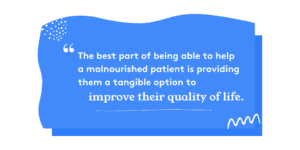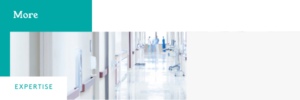Identifying Patients with Malnutrition: How It Benefits Them and Registered Dietitians
The benefits can be life-changing for a patient who is malnourished and receives vital nutrients and medical care. It can also be rewarding for a registered dietitian trained to seek out these issues.

“The best part of being able to help a malnourished patient is providing them a tangible option to improve their quality of life,” says Alyssa Bransley, a registered dietitian nutritionist at Bon Secours St. Francis Health in Greenville, S.C.
“It may be educating them about a healthy diet or helping them gain back weight after going through a rough patch or even being able to battle a disease more effectively. When I can help them, I’m providing a piece of the puzzle that can ultimately help them get better.”
But identifying these patients has other benefits, too. Haley Gostanian, a registered dietitian nutritionist at Harbor UCLA Medical Center in Torrance, Calif., says identifying these patients shows that efforts by Morrison Healthcare dietitians to educate clinicians are working.

“It can be difficult sometimes for clinicians to realize a person is malnourished, especially if they don’t show any obvious physical signs,” Haley says. “One of the best parts of identifying malnutrition in patients is proof that nurses and other clinicians are getting the message about malnutrition.”
She says education efforts are beginning to pay off. “Clinicians are able to identify patients with malnutrition more often than in the past. Physicians are consulting dietitians to assess a patient they believe may be malnourished and not just relying on a malnutrition screening tool from their initial admit.”

How Registered Dietitians Help
Registered dietitians play a vital role in helping patients admitted to the hospital. Once alerted by a nurse about a possible problem, a registered dietitian assesses a patient’s nutrition health, beginning with a series of questions regarding meal intake and weight history. Next, they perform a physical exam to identify signs of malnutrition, such as muscle wasting and fat loss.

“We gain an understanding of what emotional, environmental, and socioeconomic factors may be affecting the patient’s nutrition well-being and quality of life,” says Lauren Rocha, regional clinical nutrition manager at Palmetto General Hospital in Miami.
This approach can be life-changing for the patient. The dietitian works with the patient to develop an individualized nutrition plan to address the inadequate intake of calories, protein, and micronutrients. The plan may include the patient’s favorite foods, bedside meal assistance if physical barriers are present, a nutritional supplement, or even a referral recommendation for outpatient meal assistance.
Education is the Key
Thanks to efforts by registered dietitians such as Bransley, Gostanian and Rocha, hospital medical staff around the country are getting better at recognizing malnutrition.
While they are aware of the impact malnutrition has on patients, many physicians usually receive little to no nutrition training during medical school or residency programs. Nurses play a critical role because patients with malnutrition have a higher incidence of pressure injuries, falls, and infections, which requires more treatment and longer hospital stays.
“It’s important that nurses identify patients at risk of malnutrition when they are screened during admission so the dietitian can complete a timely assessment and start interventions as soon as possible,” says Rocha.
Once a nurse contacts a registered dietitian, patients can receive a new level of care. Because many patients don’t have access to a dietitian, they are often surprised when they get a visit from the dietitian, Rocha says. “They are grateful for the chance to ask nutrition questions and identify ways to improve their nutritional health,” she says. “The time that we spend with the patient is invaluable.”
Collecting Patient Data is Critical
To raise awareness of malnutrition among medical staff, solid data is critical. And that’s where Alyssa Bransley has made a major contribution. Using data collection and analysis skills learned as part of an internship at a Chicago hospital, she developed a comprehensive plan to help identify and treat malnutrition at her South Carolina hospital.
When she began her work about a year ago, only three percent of the hospital’s patients had been diagnosed with malnutrition — compared to 7-8 percent nationally. A recent review of data collected in the past six months shows that approximately six percent at the hospital – double the previous count – have been diagnosed with malnutrition. So, what changed?
After her initial findings, Alyssa spoke with the hospital’s dietitians and determined that many of them relied too heavily on the patient’s weight and intake information rather than physical signs of fat loss and muscle wasting.
To help them improve their knowledge, Alyssa created a comprehensive education program, including a PowerPoint presentation explaining the six specific ways to diagnose malnutrition, which focuses primarily on fat loss and muscle wasting.
The Morrison food and nutrition team have provided books on malnutrition that nurses use as a reference and online education courses, helping the nurses understand the need for an accurate weight on each patient. As a result, she steadily increased the number of patients diagnosed with malnutrition.
“It’s been exciting to see many more people get comfortable with diagnosing malnutrition,” Alyssa says. “Now that we have a larger sample size, we are hoping to see improved outcomes, such as a reduced length of stay and re-admittance rates.”
Taking a Leadership Role to ID Malnutrition
Many registered dietitians see future gains in diagnosing malnutrition tied to their ability to take on a leadership role. Rocha says it’s critical to dietitians working as part of a team with doctors and nurses to take ownership of identifying malnutrition.
“We have the unique training that allows us to wear the “nutrition-filtered” glasses to identify malnutrition and develop an individual plan of care for our patients,” she says.
“I feel personally responsible to empower as many dietitians to assess their patients for malnutrition and advocate for their patients’ nutritional needs. The more that we practice this scope of our profession, the more respect we can gain and the more impact we can make on the nutrition health of our patients.”
Learn more about Morrison Healthcare’s Malnutrition Program.





